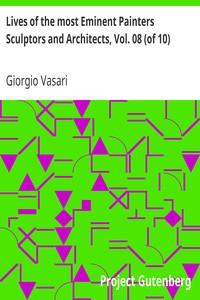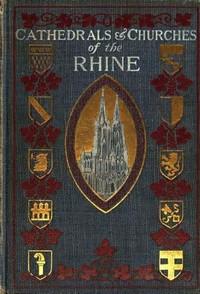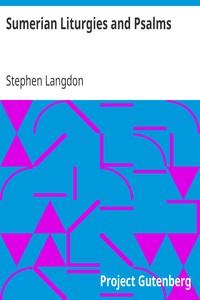Read this ebook for free! No credit card needed, absolutely nothing to pay.
Words: 74476 in 20 pages
This is an ebook sharing website. You can read the uploaded ebooks for free here. No credit cards needed, nothing to pay. If you want to own a digital copy of the ebook, or want to read offline with your favorite ebook-reader, then you can choose to buy and download the ebook.


: Lives of the most Eminent Painters Sculptors and Architects Vol. 08 (of 10) Bastiano to Taddeo Zucchero by Vasari Giorgio De Vere Gaston Du C Translator - Artists Italy Biography; Art Italian
partment in order to make certain small closets and little places of retirement, and thus deprived the Palace of a very rare work; which that holy man would not have done if he had possessed any taste for the arts of design. Giovanni painted the cartoons for those hangings and chamber-tapestries that were afterwards woven in silk and gold in Flanders, in which are certain little boys that are sporting around various festoons, and as ornaments the devices of Pope Leo and various animals copied from life. These tapestries, which are very rare works, are still in the Palace at the present day. He also executed the cartoons for some tapestries full of grotesques, which are in the first rooms of the Consistory.
While Giovanni was labouring at those works, the Palace of M. Giovan Battista dall'Aquila, which had been erected at the head of the Borgo Nuovo, near the Piazza di S. Pietro, had the greater part of the fa?ade decorated in stucco by the hand of the same master, which was held to be a remarkable work. The same Giovanni executed the paintings and all the stucco-work in the loggia of the villa that Cardinal Giulio de' Medici caused to be built under Monte Mario, wherein are animals, grotesques, festoons, and friezes of such beauty, that it appears as if in that work Giovanni had sought to outstrip and surpass his own self. Wherefore he won from that Cardinal, who much loved his genius, in addition to many benefits that he received for his relatives, the gift of a canonicate for himself at Civitale in Friuli, which was afterwards given by Giovanni to a brother of his own. Then, having to make for the same Cardinal, likewise at that villa, a fountain with the water spouting through the trunk of an elephant's head in marble, he imitated in the whole work and in every detail the Temple of Neptune, which had been discovered a short time before among the ancient ruins of the Palazzo Maggiore, all adorned with lifelike products of the sea, and wrought excellently well with various ornaments in stucco; and he even surpassed by a great measure the artistry of that ancient hall by giving great beauty to those animals, shells, and other suchlike things without number, and arranging them very well. After this he made another fountain, but in a rustic manner, in the hollow of a torrent-bed surrounded by a wood; causing water to flow in drops and fine jets from sponge-stones and stalactites, with beautiful artifice, so that it had all the appearance of a work of nature. On the highest point of those hollow rocks and sponge-stones he fashioned a large lion's head, which had around it a garland formed of maidenhair and other plants, trained there with great artistry; and no one could believe what grace these gave to that wild place, which was most beautiful in every part and beyond all conception pleasing.
That work finished, after the Cardinal had made Giovanni a Chevalier of S. Pietro, he sent him to Florence, to the end that, when a certain chamber had been made in the Palace of the Medici , he might paint and adorn it all with grotesques and stucco. That loggia having then been enclosed after the design of Michelagnolo Buonarroti, and given the form of a chamber, with two knee-shaped windows, which were the first to be made in that manner, with iron gratings, for the exterior of a palace, Giovanni adorned all the vaulting with stucco-work and painting, making in a medallion the six balls, the arms of the House of Medici, supported by three little boys executed in relief in attitudes of great beauty and grace. Besides this, he made there many most beautiful animals, and also many most lovely devices of gentlemen and lords of that illustrious house, together with some scenes in half-relief, executed in stucco; and on the field of the vaulting he did the rest of the work in pictures, counterfeiting them after the manner of cameos in black and white, and so well, that nothing better could be imagined. There remained four arches beneath the vaulting, each twelve braccia in breadth and six in height, which were not painted at that time, but many years afterwards by Giorgio Vasari, as a young man of eighteen years, when he was in the service of Duke Alessandro de' Medici, his first lord, in the year 1535; which Giorgio executed there stories from the life of Julius Caesar, in allusion to the above-named Cardinal Giulio, who had caused the work to be done. Giovanni then executed on a little barrel-shaped vault, beside that chamber, some works in stucco in the lowest of low-relief, and likewise some pictures, which are exquisite; but, although these pleased the painters that were in Florence at that time, being wrought with boldness and marvellous mastery, and filled with spirited and fantastic inventions, yet, since they were accustomed to a laboured manner of their own and to doing everything that they carried into execution with copies taken from life, they did not praise them without reserve, not being altogether decided in their minds, nor did they set themselves to imitate them, perhaps because they had not the courage.
Having then returned to Rome, Giovanni executed in the loggia of Agostino Chigi, which Raffaello had painted and was still engaged in carrying to completion, a border of large festoons right round the groins and squares of the vaulting, making there all the kinds of fruits, flowers, and leaves, season by season, and fashioning them with such artistry, that everything may be seen there living and standing out from the wall, and as natural as the reality; and so many are the various kinds of fruits and plants that are to be seen in that work, that, in order not to enumerate them one by one, I will say only this, that there are there all those that Nature has ever produced in our parts. Above the figure of a Mercury who is flying, he made, to represent Priapus, a pumpkin entwined in bind-weed, which has for testicles two egg-plants, and near the flower of the pumpkin he depicted a cluster of large purple figs, within one of which, over-ripe and bursting open, the point of the pumpkin with the flower is entering; which conceit is rendered with such grace, that no one could imagine anything better. But why say more? To sum the matter up, I venture to declare that in that kind of painting Giovanni surpassed all those who have best imitated Nature in such works, for the reason that, besides all the other things, even the flowers of the elder, of the fennel, and of the other lesser plants are there in truly astonishing perfection. There, likewise, may be seen a great abundance of animals in the lunettes, which are encircled by those festoons, and certain little boys that are holding in their hands the attributes of the Gods; and, among other things, a lion and a sea-horse, being most beautifully foreshortened, are held to be divine.
Having finished that truly extraordinary work, Giovanni executed a very beautiful bathroom in the Castello di S. Angelo, and in the Papal Palace, besides those mentioned above, many other small works, which for the sake of brevity are passed over. Raffaello having then died, whose loss much grieved Giovanni, and Pope Leo having also left this world, there was no more place in Rome for the arts of design or for any other art, and Giovanni occupied himself for many months on some works of little importance at the villa of the above-named Cardinal de' Medici. And for the arrival of Pope Adrian in Rome he did nothing but the small banners of the Castle, which he had renewed twice in the time of Pope Leo, together with the great standard that flies on the summit of the highest tower. He also executed four square banners when the Blessed Antonino, Archbishop of Florence, and S. Hubert, once Bishop of I know not what city of Flanders, were canonized as Saints by the above-mentioned Pope Adrian; of which banners, one, wherein is the figure of that S. Antonino, was given to the Church of S. Marco in Florence, where the body of the Saint lies, another, wherein is the figure of S. Hubert, was placed in S. Maria de Anima, the church of the Germans in Rome, and the other two were sent to Flanders.
Carrying that intention into effect, therefore, he went back to live in his native place with that brother to whom he had given the canonicate, determined that he would never more handle a brush. But in this also he was disappointed, for the reason that, having taken a wife and had children by her, he was in a manner forced by the instinct that a man naturally feels to bring up his children and to leave them in good circumstances, to set himself once more to work. He painted, then, at the entreaty of the father of the Chevalier Giovan Francesco di Spilimbergo, a frieze in a hall, filling it with children, festoons, fruits, and other things of fancy. After that, he adorned with lovely paintings and works in stucco the Chapel of S. Maria at Civitale; and for the Canons of the Duomo of that place he executed two most beautiful standards. And for the Confraternity of S. Maria di Castello, at Udine, he painted on a rich banner Our Lady with the Child in her arms, and an Angel full of grace who is offering to her that Castello, which stands on a hill in the centre of the city. At Venice, in the Palace of Grimani, the Patriarch of Aquileia, he decorated with stucco-work and paintings a very beautiful chamber in which are some lovely little scenes by the hand of Francesco Salviati.
Finally, in the year 1550, Giovanni went to Rome to take part in the most holy Jubilee, on foot and dressed poorly as a pilgrim, and in the company of humble folk; and he stayed there many days without being known by anyone. But one day, while going to S. Paolo, he was recognized by Giorgio Vasari, who was riding in a coach to the same Pardon in company with Messer Bindo Altoviti, who was much his friend. At first Giovanni denied that it was he, but finally he was forced to reveal himself and to confess that he had great need of Giorgio's assistance with the Pope in the matter of the pension that he had from the Piombo, which was being denied to him by one Fra Guglielmo, a Genoese sculptor, who had received that office after the death of Fra Sebastiano. Giorgio spoke of this matter to the Pope, which was the reason that the bond was renewed, and afterwards it was proposed to exchange it for a canonicate at Udine for Giovanni's son. But afterwards, being again defrauded by that Fra Guglielmo, Giovanni went from Udine to Florence, after Pope Pius had been elected, in the hope of being assisted and favoured by his Excellency with that Pontiff, by means of Vasari. Having arrived in Florence, then, he was presented by Giorgio to his most illustrious Excellency, with whom he went to Siena, and then from there to Rome, whither there also went the Lady Duchess Leonora; and in such wise was he assisted by the kindness of the Duke, that he was not only granted all that he desired, but also set to work by the Pope with a good salary to give the final completion to the last Loggia, which is the one over that which Pope Leo had formerly caused him to decorate. That finished, the same Pope commissioned him to retouch all that first Loggia, which was an error and a thing very ill considered, for the reason that retouching it "a secco" caused it to lose all those masterly strokes that had been drawn by Giovanni's brush in all the excellence of his best days, and also the boldness and freshness that had made it in its original condition so rare a work.
After finishing that work, Giovanni, being seventy years of age, finished also the course of his life, in the year 1564, rendering up his spirit to God in that most noble city which had enabled him for many years to live with so much success and so great a name. Giovanni was always, but much more in his last years, a God-fearing man and a good Christian. In his youth he took pleasure in scarcely any other thing but hunting and fowling; and his custom when he was young was to go hunting on feast-days with his servant, at times roaming over the Campagna to a distance of ten miles from Rome. He could shoot very well with the fusil and the crossbow, and therefore rarely returned home without his servant being laden with wild geese, ringdoves, wild ducks, and other creatures such as are to be found in those marshy places. Giovanni, so many declare, was the inventor of the ox painted on canvas that is made for using in that pursuit, so as to fire off the fusil without being seen by the wild creatures; and on account of those exercises of hunting and fowling he always delighted to keep dogs and to train them by himself.
Giovanni, who deserves to be extolled among the greatest masters of his profession, chose to be buried in the Ritonda, near his master Raffaello da Urbino, in order not to be divided in death from him to whom in life his spirit was always attached; and since, as has been told, each of them was an excellent Christian, it may be believed that they are still together in eternal blessedness.
BATTISTA FRANCO
LIFE OF BATTISTA FRANCO
PAINTER OF VENICE
Free books android app tbrJar TBR JAR Read Free books online gutenberg
More posts by @FreeBooks

: The Cathedrals and Churches of the Rhine by Mansfield M F Milburg Francisco McManus Blanche Illustrator - Rhine River Valley Description and travel; Cathedrals Rhine River Valley; Church architecture Rhine River Valley


: Sumerian Liturgies and Psalms by Langdon Stephen - Sumerian language Texts; Hymns Sumerian; Sumerians Religion






